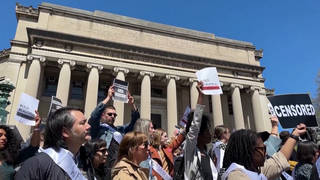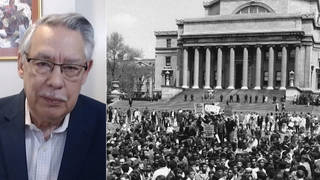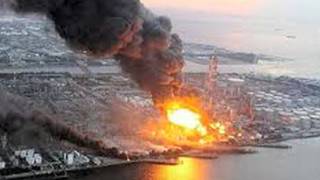
Related
Topics
Guests
- Louis Carletexecutive president of the Tokyo General Union
- Laura Kongdirector of the International Tsunami Information Center based in Hawaii.
- Emile Okalgeophysicist at Northwestern University. He is currently living on the Pacific island of Tahiti, where he is on a research visit to the Laboratoire de Géophysique, the center that serves as the tsunami warning center for Polynesia.
- Phil Cumminsseismologist at Australian National University
Japan has been hit with a massive 8.9-magnitude earthquake, one of the strongest ever recorded. The quake triggered a 10-meter-high tsunami along Japan’s northern coastline, and nations and island states throughout the Pacific Ocean Basin are on alert for rising sea waters as the tsunami travels out from the epicenter. Police and local officials report at least 200 people were initially killed, but the death toll is expected to rise significantly. [includes rush transcript]
Transcript
JUAN GONZALEZ: Japan has been hit with a massive 8.9-magnitude earthquake, one of the strongest earthquakes ever recorded. The quake triggered a 10-meter-high tsunami along Japan’s northern coastline. Japanese television showed cars, ships and even buildings being swept away by a vast wall of water. Widespread fires are burning out of control. Police and local officials said at least 60 had been killed in the earthquake and the tsunami, but the death toll is expected to rise significantly. Japanese media reported a ship carrying 100 people was swept away. It is not clear what happened to the ship and its passengers.
AMY GOODMAN: The Japanese government declared a nuclear emergency after the earthquake. Two thousand residents near the Fukushima nuclear power plant have been evacuated from their homes after the cooling system at the plant failed. Meanwhile, a fire has broken out in the turbine building the Onagawa nuclear plant. A massive fire has also broken out at a large oil refinery it in Chiba northeast of Tokyo.
The quake struck at 2:46 p.m. local time and was followed by a series of powerful aftershocks, including a 7.4-magnitude one about 30 minutes later. A tsunami warning has been issued for nearly the entire Pacific Basin. Among the countries issued a warning are Russia, the Philippines, Indonesia, Papua New Guinea, Fiji, Mexico, Guatemala, El Salvador, Costa Rica, Nicaragua, Honduras, Chile, Ecuador, Colombia and Peru. In the United States, a tsunami warning has been issued for Hawaii, the central and northern California coast, Oregon and Washington state.
We go now to Japan, where we’re joined by Louis Carlet, executive president of the Tokyo General Union.
Welcome to Democracy Now! Tell us what happened, what Japan experienced, in this, one of the largest — what’s being called the Great Quake, the Great Earthquake, one of the five largest in the last century.
LOUIS CARLET: Yeah, Japanese media is saying that it’s actually the largest ever recorded. I’m here now in central Tokyo, and I was here today when it first hit. Just to give you an idea, I mean, our office, all the cabinets and everything was completely turned over, and the floor was covered with papers and documents. And we are very far from the epicenter, which is, as you know, up in northern Japan.
JUAN GONZALEZ: And in terms of the tsunami, when it hit, about how far — how long after the earthquake? And what can you tell in terms of the damage that’s been reported on the news?
LOUIS CARLET: Yeah, well, there were — several tsunamis hit. One hit very soon after the first earthquake. And I should say, there have been aftershocks almost continuously since the first earthquake hit. As far as the media, right now they’re reporting at least 68 confirmed dead. And they’ve been very open about expecting a huge increase in that overnight, and tomorrow we’re expecting a really grim picture to emerge.
AMY GOODMAN: And tell us who you represent. Who does the Tokyo General Union represent?
LOUIS CARLET: We are a multi-ethnic union. We represent workers in Japan from all over the world, including the Philippines, France, United States, England, as well as Japanese workers. And we’re the largest multi-ethnic labor union in Japan.
AMY GOODMAN: We are also joined by Laura Kong. She is the director of the International Tsunami Information Center based in Hawaii — a tsunami warning for just about now. Laura Kong, what information can you bring us?
LAURA KONG: Only that we believe the wave has probably already arrived, so we don’t have any reports right now of seeing anything in Hawaii. But we are in a warning in Hawaii, and the state has and all the coasts have been evacuated. We’ve been in a warning for about four or five hours with an evacuation.
JUAN GONZALEZ: Is there any way you can tell where the — because there are so many, obviously, countries in the Pacific Basin that have been put on alert. Any likely direction for the strongest parts of the tsunami, which countries might be most in danger?
LAURA KONG: Well, you know, clearly, after Japan, a lot of the energy is directed towards Hawaii, and there’s some fingers that are headed perhaps to parts of the Pacific Northwest. But it looks like some of our — the coastal forecast that the Pacific Tsunami Warning Center has been looking at, they’re estimating things of certainly less than a meter or two. But really, that’s an amplitude. But we’re waiting to see how waves are occurring or observed in Hawaii before going further with anything more on whether the warning will continue or be canceled.
AMY GOODMAN: The AP has put out a news alert, Laura Kong, saying “Tsunami waves slam Hawaii, waves sweeping through islands.”
LAURA KONG: Certainly, a tsunami is a series of waves, and it does sweep across the ocean, and it would hit all parts of the island. But, you know, it is the middle of the night here, and unless they have specific eyewitness observations, it would be a little bit difficult to say that. We do have field-level or tide gauges that are measuring, but I haven’t seen the readings yet.
AMY GOODMAN: How many people have to be evacuated, and where do they go?
LAURA KONG: Here in Hawaii, we have evacuation maps, since the 1990s, and they’re in the phone book. So all of our residents are very well aware. And especially after the Chile event in February of 2010, we all know what a tsunami is. We all know where to go. By and large, most of the residents have retreated inland, or they’ve gone to shelters or to their family or friends. And within Waikiki, where most of our tourists are, there we have a policy of vertical evacuation or sheltering in place. So the hotels that are tall, reinforced concrete buildings, the hotel guests would go upstairs above the third floor.
AMY GOODMAN: We’re also going to Tahiti. Emile Okal is joining us, a geophysicist at Northwestern University, speaking to us from the Pacific island of Tahiti, where he is on a research visit to the Laboratoire de Géophysique. The center serves as the tsunami warning center for Polynesia.
Welcome to Democracy Now!, Professor. Tell us what is happening in Tahiti right now.
EMILE OKAL: Hello. Well, in Tahiti right now, we are just about starting a red alert, which means that the shorelines will be evacuated. We are monitoring the situation in Hawaii, of course. We have, to some extent, the luxury of time, because the waves will not come until 7:00, which is four hours from now, because of a greater distance. We are monitoring. We’ve run a number of simulations. And we are really eager to know what’s going on in Hawaii at this point. The sirens should be ringing in Tahiti probably momentarily.
AMY GOODMAN: And explain —
EMILE OKAL: Can you hear me?
AMY GOODMAN: Yes, we can. Explain what kind of warnings are going out. What are you telling people to do? And explain for us exactly how a tsunami works, after this great quake that, well, is being called one of the biggest, if not the biggest, recorded.
EMILE OKAL: Well, first of all, yes, indeed, it’s the biggest earthquake in Japan recorded since we have instruments to record them, which means something in the order of 120, 130 years of records.
Now, what happens is you shake the bottom of the ocean, and that disturbs the water, and essentially in the same way that if you kick a bucket you’re going to create a ripple, which propagates at the surface of the water. And on a much greater scale, this is what’s happening in the Pacific Ocean. We’ve kicked the bottom of the ocean, and we’ve deformed it in Japan, and there is a ripple propagating all across the ocean at present.
Now, what we are doing here, as scientists, we have been in touch throughout the night. We have been in touch with civil defense authorities and the governor’s office. And it is their decision, of course, to order an evacuation, which has just been ordered, and that means that the sirens will sound in all the islands, wake up those residents which are not aware of the situation yet. And they will move to higher grounds to be out of harm’s way.
Interestingly enough, I think yesterday or the day before, on the eastern shore of Tahiti, there was a tsunami drill, where the students in the high schools and some critical communities were asked to, in a sense, rehearse evacuation during a tsunami. So, they should certainly know very well what to do. The memory is fresh, and the awareness is there. So this is what’s going to happen. The people are going to move away from the shoreline to locations which are out of harm’s way.
JUAN GONZALEZ: And Professor Okal, have you gotten any indication in terms of other islands that are closer to the epicenter of the earthquake? I’m thinking of many of the offshore Japanese islands, possibly even Okinawa, in terms of the impact there.
EMILE OKAL: Well, this is very different, because, you see, Okinawa is in the Ryukyus, and this is in a completely different direction from the epicenter. And it turns out that tsunamis are extremely directive, and the bulk of the energy goes at right angles from the fault. So, this is why it goes into the Pacific Ocean into an area where you don’t have too many islands in the first place. We’ve had reports at Midway Island of 1.5 meters, and we are monitoring the situation in Tarawa, Johnston and other islands. And of course, we are very eager to know what’s going on in Hawaii.
AMY GOODMAN: We’re going to go back to Louis Carlet in a minute. But, Professor Okal, I just wanted to ask you, I mean, the casualty figures now are set at 40, though expected to be higher. But the scary, frightening images that we’re seeing indicate it will be far higher. In fact, we heard possibly a ship is lost at sea of a hundred people. But the frightening image of the tsunami coming up on land on Japan. Talk about exactly what you understand happened. Sure, you’re in Tahiti, but this is your expertise.
EMILE OKAL: What happens, well, this is what we’ve seen on television. You know, the wave reaches the shoreline and does not necessarily behave like a regular wave on the ocean, which breaks at the shoreline. It has the capacity to actually rise a little bit as a tide and to move inland, sweeping everything which it finds in its path — cars, houses, boats, you name it. And these are the images that we’ve seen. And at this point, you know, man is completely powerless. And certainly, we are going to look at figures which are much higher than the numbers that you quoted. I wouldn’t be surprised if we reach a thousand or more casualties. Japan is very well prepared. There is a great deal of awareness. The population is well educated. But in a disaster of this kind, the figures are going to rise. That’s unavoidable.
JUAN GONZALEZ: I’d like to bring back Louis Carlet, who’s in Tokyo. There have been reports, obviously, of a danger, a potential danger, to many of the nuclear power plants in Japan, about 11 of them the government has automatically shut down, but that a fire broke out within the bounds of one of the plants. Are you receiving any more news about the situation with the nuclear power plants?
LOUIS CARLET: Yeah. The one thing I have heard from the Japanese media is that they’ve set up an emergency panel to take, you know, countermeasures as soon as possible. They’ve been very careful to assert that there’s been no confirmation of any leak yet.
AMY GOODMAN: And the oil refinery, the fire?
LOUIS CARLET: Yeah, I mean, you probably have seen as much as I’ve seen in terms of that. I’d just like to say also that in Tokyo, one of the big issues here is that a lot of workers here cannot go home, because most of — almost all the trains have stopped. And so, a lot of people are ending up staying over in their office, and they can’t contact their loved ones and stuff like that. So it’s really a huge issue here, and people feel kind of out of the loop, you know?
AMY GOODMAN: Explain when you say they can’t contact their loved ones. You have no cell phone service?
LOUIS CARLET: Almost no cell phone service. I’ve tried hundreds of times today and got through twice. And many companies, there’s just absolutely no service. And even land line service, most of it is down. The electricity in Tokyo, thankfully, is not down, although it is up in northern Tokyo.
AMY GOODMAN: And what’s also amazing, though, is the buildings that have remained standing. Can you explain how Japan — I mean, unlike what we saw, for example, in Banda Aceh, unlike what we have seen certainly in Haiti, when an earthquake strikes, the preparation of these buildings, how they’re structurally sound?
LOUIS CARLET: Yeah. Well, many of them are, although there are many buildings that have violated the earthquake codes. They have gotten better over the years. And some of them — there was a report of one building nearby that partially collapsed. But Tokyo, most of them are OK, it seems. And that’s really — I mean, there’s a lot of preparation, a lot of drilling and stuff like that. And you could see that today. I mean, everyone left the buildings, and there were police and firefighters going around, you know, like in a kind of a drilled response or something like that.
AMY GOODMAN: We’re also joined by Phil Cummins, a seismologist at Australian National University, who’s been credited with predicting the 2004 Indian Ocean tsunami. Did you predict that this would happen, this earthquake that has now led to a tsunami that is threatening the whole Pacific Basin, Phil Cummins?
PHIL CUMMINS: Definitely not. It was as much a surprise to me as it was to anyone else. And I don’t think I could describe myself as having predicted the Indian Ocean tsunami, either, frankly.
AMY GOODMAN: Talk about your assessment of what’s happening right now.
PHIL CUMMINS: Well, obviously a major earthquake. This is the fifth-largest earthquake ever recorded, largest instrumentally recorded in Japan. It occurred along a coastline that hasn’t experienced an earthquake anywhere near that size in, well, over a hundred years. There was a large tsunami in 1896, but that affected the coast northward of this one, and I don’t think it was anywhere near as large as this tsunami has been.
JUAN GONZALEZ: And is your sense that the worst impact of the tsunami will be felt, obviously, in Japan, and that as it goes across the Pacific it will get weaker and weaker?
PHIL CUMMINS: Well, in general, that’s true. But the tsunami energy is highly directed, and it will run up when it gets into shallow water, even after it’s crossed the entire Pacific. It can be focused, and it’ll run up to higher heights. So there will be places where it still runs up to heights that can be damaging.
AMY GOODMAN: How is Australia dealing with this, Phil Cummins? Where are you in Australia? And what causes an earthquake?
PHIL CUMMINS: Well, I’m in Canberra, so I’m quite far from the coast, so I think I’m relatively safe. Australia is quite lucky, especially in an earthquake like this, because we’re surrounded by, you know, some island chains and relatively shallow water. So we’re pretty much shielded from the effect of a tsunami that occurs in Japan, I would say.
AMY GOODMAN: Well, I want to thank you very much for being with us, Phil Cummins, seismologist at Australian National University in Canberra; as well to Louis Carlet, executive president of the Tokyo General Union — of course, we’ll be back to you; and Emile Okal, geophysicist at Northwestern University, speaking to us from Tahiti. Thanks, all, for being with us.










Media Options